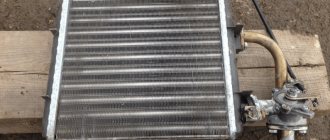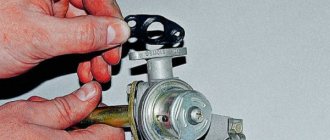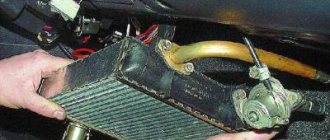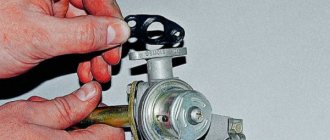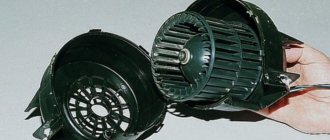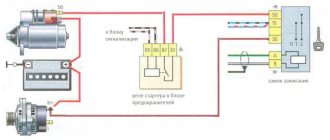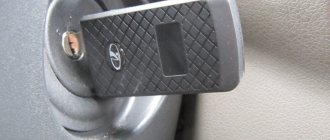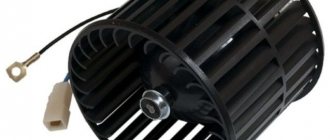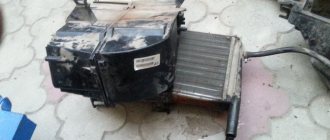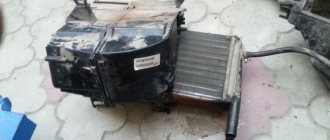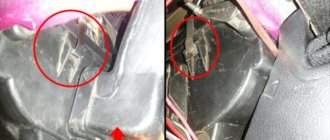Purpose and principle of operation of the VAZ-2107 heater radiator
The source of heat in the heating system of the VAZ-2107 car is the liquid with which the cooling system is filled. The cooling system is designed in such a way that the heater radiator is part of its overall circuit. The principle of operation of the radiator is that air flows, penetrating into the car through the air intake on the hood, enter the heating compartment, where they are heated by the heater radiator and move further through the air ducts into the passenger compartment.
The VAZ-2107 heater radiator is a key element of the vehicle heating system
The degree of heating of the air directed into the car interior depends on the temperature of the coolant and the position of the heater valve damper. You can adjust the position of the faucet using the upper slider of the heating system control mechanism: the extreme left position of the slider means that the faucet is closed and the stove is not working, the extreme right position means the faucet is fully open.
The position of the tap can be adjusted using the upper slider of the heating system control mechanism
Initially, the heater radiators of the VAZ-2107 (and other “classic” models) were made exclusively of copper. Currently, many car owners, in order to save money, install aluminum heater radiators, which, although they are cheaper than copper ones, have worse heat transfer rates. The aluminum radiator does not always cope with the large flow of frosty air entering the air intake when driving on the highway, and in this case the interior does not warm up enough.
The heater radiator can be two or three rows . The heat exchanger has a horizontal position and is housed in a special plastic housing. The radiator is attached to the body with two self-tapping screws, the tap is mounted in the supply pipe. Structurally, the radiator consists of:
- systems of tubes located in honeycomb ribs that improve heat transfer;
- inlet and return tanks;
- inlet and outlet pipes.
Video: recommendations for choosing a VAZ-2107 heater radiator
The cross-section of the tubes can be round or square . Round tubes are easier to manufacture, but the heat transfer of such products is lower than that of square ones, so so-called turbulators are placed inside the round tubes - spiral-shaped plastic strips that help increase heat transfer rates due to turbulence and mixing of the refrigerant. In flat tubes, turbulence is created due to their shape, so additional elements are not required.
The dimensions of the three-row copper radiator SHAAZ are:
- length - 254 mm;
- width - 67 mm;
- height - 184 mm.
Product weight - 2.2 kg.
A double-row aluminum radiator may have other dimensions.
Features of replacing the stove on a VAZ-2107
The work of replacing the stove on a VAZ-2107 does not have any significant difficulties in execution. Despite this, you will have to disassemble a significant part of the car’s dashboard. Therefore, before starting work, you need to find out whether it is really necessary to replace or dismantle the heater.
We recommend: Changing the gasket under the valve cover on a Chevrolet Lacetti: articles, tips and sealant
Key indicators for removing the stove
The main indicator for dismantling the heating element is liquid leakage. It is not difficult to determine such a breakdown - in the event of an antifreeze leak, a puddle appears under the rug of the front passenger seat. Then an urgent replacement of the radiator is required, since when the coolant evaporates, it releases toxic gases that can cause significant harm to human health. The radiator can be replaced only after dismantling the vehicle heater.
The next indicator for removing the heating element is the supply of cold air to the interior of the car. If the radiator tap is open and the stove does not heat, then it must be removed and the cause of the breakdown must be looked for. Most often in this case the problem is in the faucet, clogged pipes or radiator. Only after dismantling the stove can the fault be identified and corrected. There are times when the stove cannot be repaired, then you will have to buy a new product.
Preparatory stage
Let us consider in detail how to remove the stove so as not to damage the plastic parts of the body, fasteners and parts of the heating system. The work of dismantling the product requires attentiveness and accuracy from the performer.
To get started, stock up on all the necessary tools. To remove the heater, you will need a Phillips screwdriver, keys 7 and 10, a container for draining antifreeze, unnecessary pieces of fabric or rags. The fact is that when dismantling the stove, you will have to unscrew the radiator pipes, from which antifreeze will flow. To prevent toxic liquid from getting on the mats, you need to cover the bottom of the car well. Also, to install a repaired stove, you will need rubber gaskets and antifreeze for topping up.
When you have all the necessary parts in stock, you can proceed directly to removing the VAZ-2107 heater.
The procedure for removing the VAZ-2107 stove
First, let's begin dismantling the heater housing in the car's interior. Initially, the radio panel is removed, which is attached with self-tapping screws, the glove box is dismantled, and the fan is unscrewed.
Now let's move on to the engine compartment. First, remove all the clamps that secure the heater valve pipes and hoses. The hoses are dismantled very carefully so as not to injure your hands on the manifold. Next, using a 7mm socket, the fasteners of the heater seal to the car body are unscrewed, and the sealing element is removed from the pipes. Further work on disassembling the stove is carried out inside the car. To get to the radiator, you need to remove the casing of the faucet adjustment cable and remove the loop from the lever.
The radiator no longer holds anything, it must be removed and disassembled. Initially, use a 10mm wrench to unscrew the two mounting bolts and remove the radiator pipe and valve. There are rubber seals between the pipe and the radiator, which must be replaced when assembling the heater.
As a result of the manipulations carried out, there is a completely disassembled VAZ-2107 stove. Further actions depend on the purpose for which the product was dismantled.
Carrying out heater diagnostics
Before starting to assemble the product, a visual inspection of the heating system parts is carried out. The most common cause of heater malfunction is deposits in the heater tap, due to which coolant does not flow into the radiator. The breakdown is eliminated by replacing the tap with a new product.
A heating problem can also be caused by a clogged radiator and pipes. In this case, the radiator will need to be flushed. To do this, you need a special liquid or citric acid solution. You need to take three hundred grams of acid per five liters of water and use a compressor to rinse the product. If the actions taken did not give the desired result, namely good tube capacity, then you need to purchase a new product.
Sometimes when removing the heating element, obvious damage is visible on it or the pipes. In this case, you will also have to buy a new product. Some craftsmen repair holes by soldering damaged elements, however, such repairs will not give long-lasting results.
To properly heat the interior, you need to purchase a new radiator. There are two types of stoves on sale for the VAZ-2107. From the factory, the car is equipped with a copper radiator, which has high heat transfer, but has a low service life. Aluminum heaters are considered more reliable, however, their level of heat transfer is much lower. It’s up to you to decide which part to purchase, since in this case you have to choose between comfort and practicality. After troubleshooting the heating system or purchasing a new radiator, you can proceed directly to assembling the stove.
Features of installing the stove on a VAZ-2107
Assembly and installation of heating elements on the car is carried out in the reverse order. First you need to assemble the radiator. To do this, the pipes and heater valve are screwed to it. In this case, it is important to install new sealing rubber bands to avoid repeated leakage of the heating system.
The radiator is installed in the seat, the tubes are led out through the holes into the engine compartment. A standard seal is installed on the motor side and secured with bolts. Nozzles are put on the tubes and secured with clamps.
On the interior side, the heater tap adjustment cable is secured and adjusted so that the lever fully opens and closes the tap. Before proceeding with the complete assembly of the torpedo, it is necessary to check the connecting elements of the system for fluid leaks. To do this, you need to open the radiator tap and start the engine. Then you can add antifreeze to the system and assemble the heater housing, radio, and install the glove compartment. Be sure to connect the wiring so you don't have to disassemble the heater again.
How to choose the best heater radiator for VAZ-2107
To optimize the operation of the stove, VAZ-2107 owners quite often replace the standard radiator with a heat exchanger from another domestic model or a foreign car.
Radiators of other VAZ models
An alternative to the factory radiator of the VAZ-2107 stove can be a similar product from the “five”. In general, for the “classics” there are two types of stove radiators - VAZ-2101 and VAZ-2105. Of course, the seventh model is suitable for a “five” heat exchanger. The standard size of a standard radiator from a “kopek” is 185x215x62 mm, from a “five” - 195x215x50 mm, i.e. the product from a VAZ-2101 will not fit into the plastic casing of a “seven” due to its thickness.
Read about the design of the VAZ 2105: https://bumper.guru/klassicheskie-modeli-vaz/poleznoe/vaz-2105-inzhektor.html
Video: which stove radiator is suitable for the “seven”
If the car owner decides to replace the entire stove, then the most acceptable option is a heater from a VAZ-2108.
From a foreign car
Instead of the “native” heater radiator on the VAZ-2107, you can install a “foreign” one, if it fits in size. Practice has shown that a copper heat exchanger from Mitsubishi turned out to be quite suitable for installation in the “seven”.
I had several classic VAZs, and different radiators in the stoves and in the cooling system. Based on operating experience, I can say one thing: the heat transfer is almost the same due to the metal tanks and an additional row of cassettes; it is almost not inferior in heat transfer to an aluminum radiator. But aluminum weighs less and is practically not subject to thermal expansion. Yes, its heat dissipation is better; when you open the heater tap, brass produces heat in almost a minute, and aluminum in a couple of seconds. The only negative is the strength, but in our country everyone is trying not to attract masters, but to do something themselves with crooked hands using a crowbar and a sledgehammer. And aluminum is a delicate metal, you need to be gentle with it, and then everything will be fine. And many say that the pressure in the cooling system is vomiting them. So, if you monitor the valves of the expansion caps and the cooling radiator, then there will be no excess pressure.
Madzh
https://otzovik.com/review_2636026.html
Dismantling algorithm
VAZ cars of the classic family, which includes modification 2107, are good because to remove the heater radiator you do not need to dismantle the front panel, so the work of removing the heat exchanger of the interior heating system is not difficult. No specific tools are required, just 8 and 10 size screwdrivers and wrenches are needed.
Algorithm for removing the heater radiator:
- Drain the coolant by unscrewing the drain plugs on the engine and main radiator.
- On the left side of the engine shield (standing in front of the car) we look for two rubber tubes through which coolant is supplied and discharged to the heater. We loosen the clamps of these tubes and tighten them.
- We unscrew the screws securing the rubber seal through which the metal radiator pipes pass. Let's remove the seal.
- We move to the salon.
- We dismantle the shelf under the storage compartment on the passenger side. To do this, you need to unscrew the screws that secure it.
- Remove the lower part of the center console. It is attached to the floor and front panel with self-tapping screws. Since keys, a cigarette lighter, and a clock are installed on the lower part, after unscrewing the fastening elements, we move the box toward you (by turning on the reverse gear at the gearbox) and disconnect the wiring going to the indicated elements (it is better to mark the wires so as not to confuse them during assembly). After this, the box can be removed from the cabin.
- Unscrew the control mechanism cable from the antifreeze supply shut-off valve.
- We disconnect the lower part in which the fan is located from the stove body. It is attached to the top of the case using 4 latches installed on the sides. Use a screwdriver to pry up the latches, after which the lower part of the case will drop down. We move it to the side or completely remove it, having first disconnected the power wires of the fan motor.
- After dismantling the bottom of the case, you will have access to the radiator, which can be removed by pulling it down using the metal pipes.
Radiator installation
We recommend: How to decarbonize an engine with your own hands?
Note that this is only one of the methods for disassembling the stove on a VAZ-2107. It is not necessary to drain the antifreeze; you can disconnect the rubber tubes without removing them, and 1.0-1.5 liters of coolant will flow out of the cooling system, which are topped up after assembly. The main thing is that after disconnecting the tubes, lift their ends up and secure them in this position.
During the disassembly process, you can immediately disconnect the pipelines from the radiator along with the shut-off valve and then remove the heat exchanger itself.
